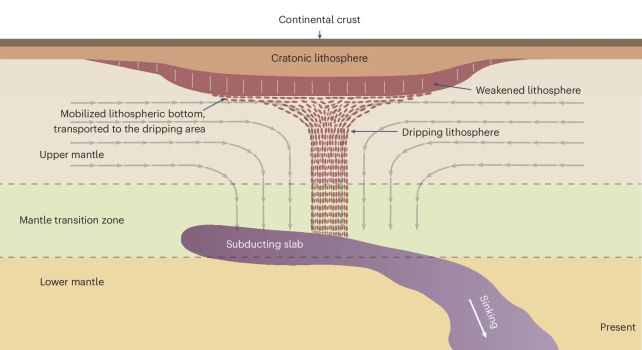Beneath the American Midwest, on the continent of North America, the underside of Earth's crust is dripping into the planetary interior.
There, blobs of molten rock are coalescing in the upper mantle of the planet, eventually gaining enough mass to precipitate deeper, a slow, gradual mechanism revealed through seismic monitoring that shows the thinning lithosphere underlying the region.
It's nothing to worry about. Only recently discovered, lithospheric dripping occurs in other parts of the world, too – but the revelation opens a new window onto our dynamic Earth's unique geological processes.
"This sort of thing is important if we want to understand how a planet has evolved over a long time," explains geophysicist Thorsten Becker of the University of Texas at Austin. "It helps us understand how do you make continents, how do you break them, and how do you recycle them."
The type of lithosphere here is a craton – a particularly large, stable section of Earth's crust that has been around, relatively unchanged, for a very long period of time. Because they are so stable, they are thought to be the nuclei around which continents form. We know of around 35 cratons lurking beneath our feet.
Lithospheric dripping occurs when the underside of Earth's rocky crust is heated to a certain temperature. As the rock melts, a drop starts to form, eventually becoming weighty enough to break off and fall away deeper into the planet. It's a bit like an extreme version of a pitch drop experiment.
In some cases, like in the Andes and Türkiye's Anatolian Plateau, this process can create wrinkles on the planet's surface that betray the activity occurring below. In this case, however, a team led by seismologist Junlin Hua, currently of the University of Science and Technology of China but at the University of Texas while undertaking this research, used seismic data to reconstruct the activity on the underside of Earth's crust.

They used a computer model that builds a tomographic map of Earth's crust from seismic data collected by the EarthScope Consortium. It's like taking an X-ray of the crust, revealing where it is thickest and thinnest, and how its density varies.
"Because of the use of this full-waveform method, we have a better representation of that important zone between the deep mantle and the shallower lithosphere where we would expect to get clues on what's happening with the lithosphere," Becker explains.
The team's work reveals that the craton that sits under most of the North American continent is thinning, with the focal point beneath the Midwest of the US, and the probable cause is lithospheric dripping.
What's even more intriguing is what's causing it. Some 600 kilometers (373 miles) from the craton, the ancient Farallon tectonic plate is sliding underneath the North American tectonic plate, a process known as subduction.
This process has been playing out for hundreds of millions of years; by this point, the Farallon plate has been almost entirely subducted, with the bulk of it now sitting in the lower mantle, underneath the North American plate. The seismic data suggests that its presence is redirecting large-scale mantle flows that shear the bottom of the craton, weakening it.
The dripping process could then be exacerbated by prior weakening of the lithosphere; an example of this would be through the release of volatiles from the remnants of the subducting Farallon slab.
Together, these processes could soften and weaken the underside of the craton enough to facilitate lithospheric dripping, thinning the craton around which the continent is structured.
Although the focal point is under the Midwest, the effects are widespread across the entire craton, the researchers found. But it's a process that has timescales of millions to billions of years, and is unlikely to affect anyone living on the North American continent for many generations to come.
The research has been published in Nature Geoscience.
